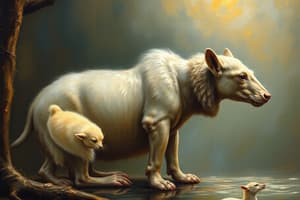Podcast
Questions and Answers
Describe some features common to all mammals.
Describe some features common to all mammals.
mammary glands, fur, four chambered heart
Which of the following is a characteristic of mammals?
Which of the following is a characteristic of mammals?
- They have a backbone (correct)
- They lay eggs
- They have fur or hair (correct)
- They are cold-blooded
Describe a herbivore and the structure and function of their teeth.
Describe a herbivore and the structure and function of their teeth.
Herbivores are animals whose digestive system is structured to eat producers (plants). They have chisel-like incisors for cutting plants, most do not have canines, and they have large flat molars for chewing.
Describe a carnivore and the structure and function of their teeth.
Describe a carnivore and the structure and function of their teeth.
What are the main differences and similarities between carnivore and herbivore dentition?
What are the main differences and similarities between carnivore and herbivore dentition?
Describe an omnivore and the structure and function of their teeth.
Describe an omnivore and the structure and function of their teeth.
Flashcards are hidden until you start studying
Study Notes
Mammals
- Characterized by mammary glands, fur, and a four-chambered heart.
- Possess a backbone and are warm-blooded.
- Feed their young with milk produced by mammary glands.
Herbivores
- Digestive system specialized for consuming plants (producers).
- Incisors are chisel-like and located at the front, ideal for cutting plants.
- Molars are large and flat, located at the rear, used for grinding and chewing foliage.
- Lack prominent canines, although some may have tusks for defense.
- Enhanced surface area on molars assists the enzyme 'amylase' in breaking down tough plant cell walls.
Carnivores
- Adapted to consume other animals (consumers).
- Incisors at the front are used for cutting meat from bones.
- Sharp canines are designed for tearing flesh and piercing vital organs of prey.
- Have carnassials, specialized molars that work vertically to create significant biting force, capable of crushing bones and slicing food into manageable pieces.
Differences and Similarities in Dentition
- Differences:
- Carnivores have sharp canines and carnassials, while herbivores possess flat molars tailored for grinding.
- Similarities:
- Both groups have incisors; some herbivores may have canines for defense.
Omnivores
- Capable of consuming both plants (producers) and animals (consumers).
- Chisel-like incisors at the front are used for cutting various food sources, including meat and plant matter.
- Canines are sharp and effective for ripping and tearing.
- Molars are flat with a broad surface area to grind plants effectively and help in the digestion of tough cell walls using 'amylase'.
Studying That Suits You
Use AI to generate personalized quizzes and flashcards to suit your learning preferences.




